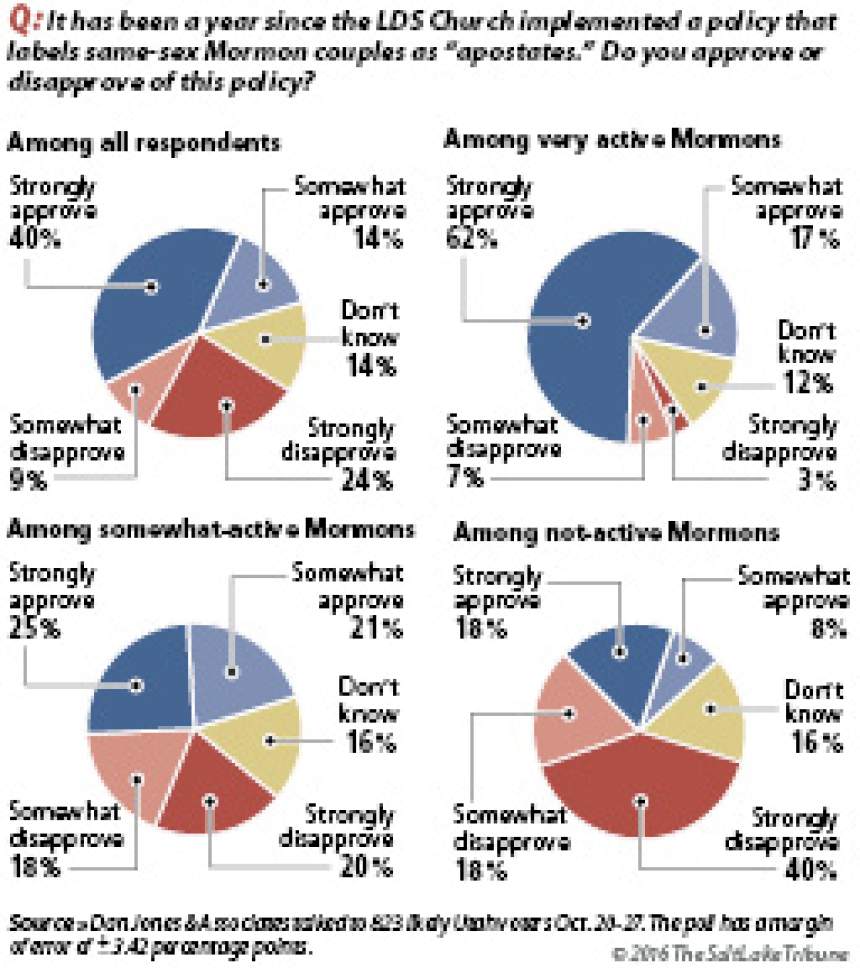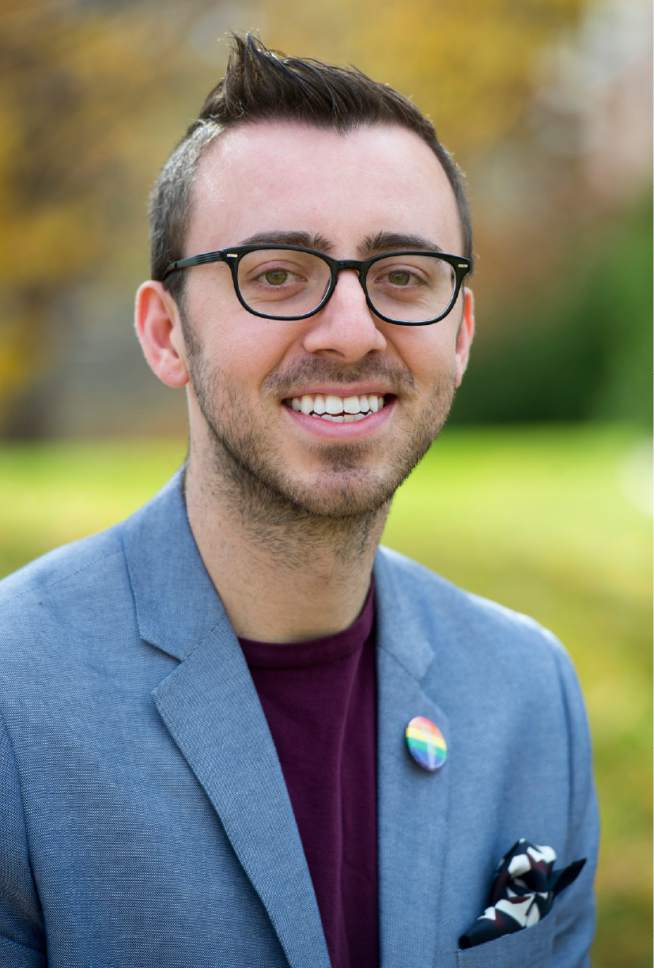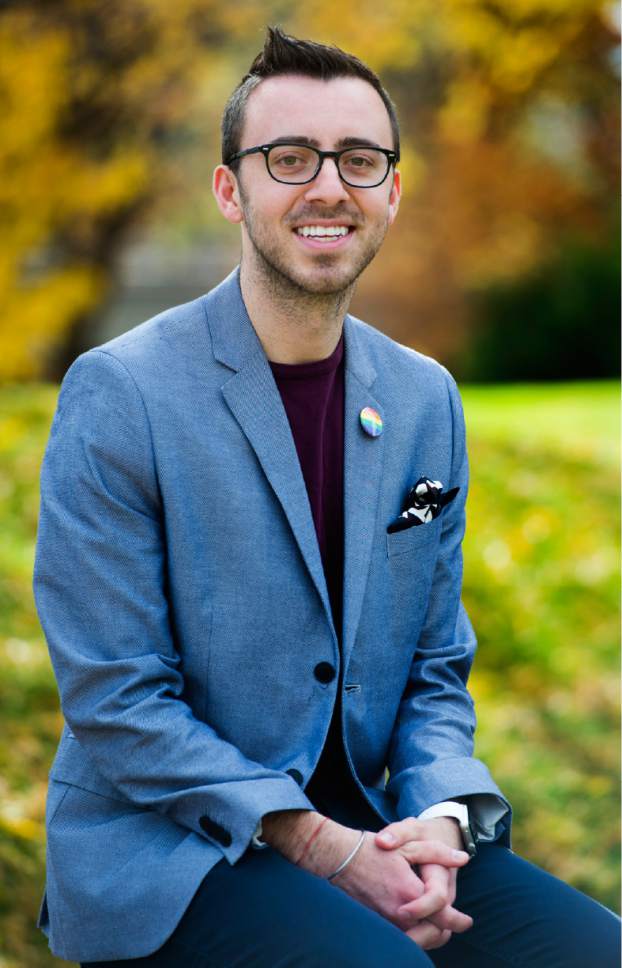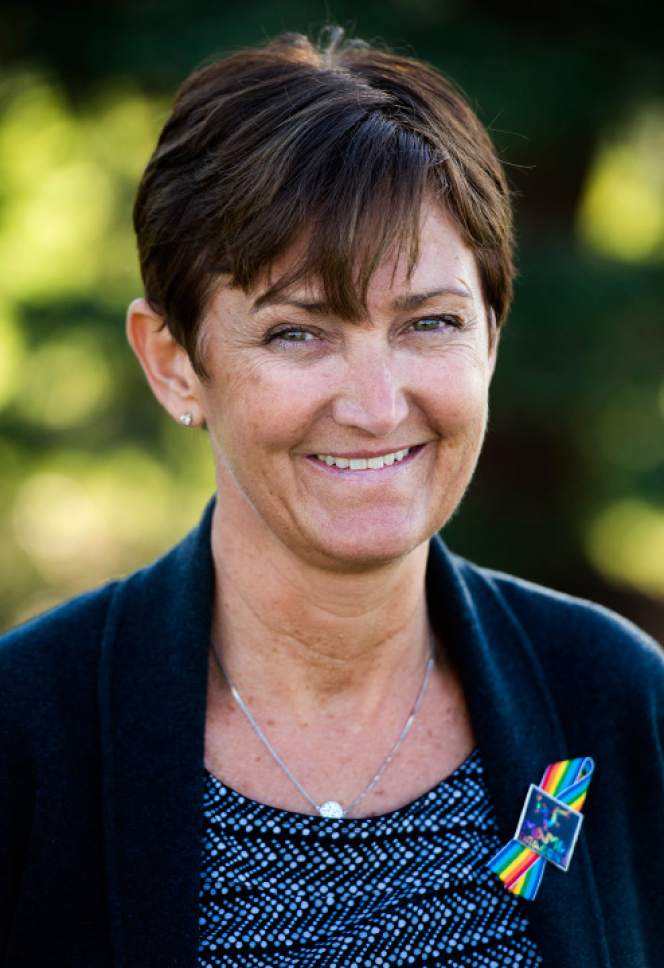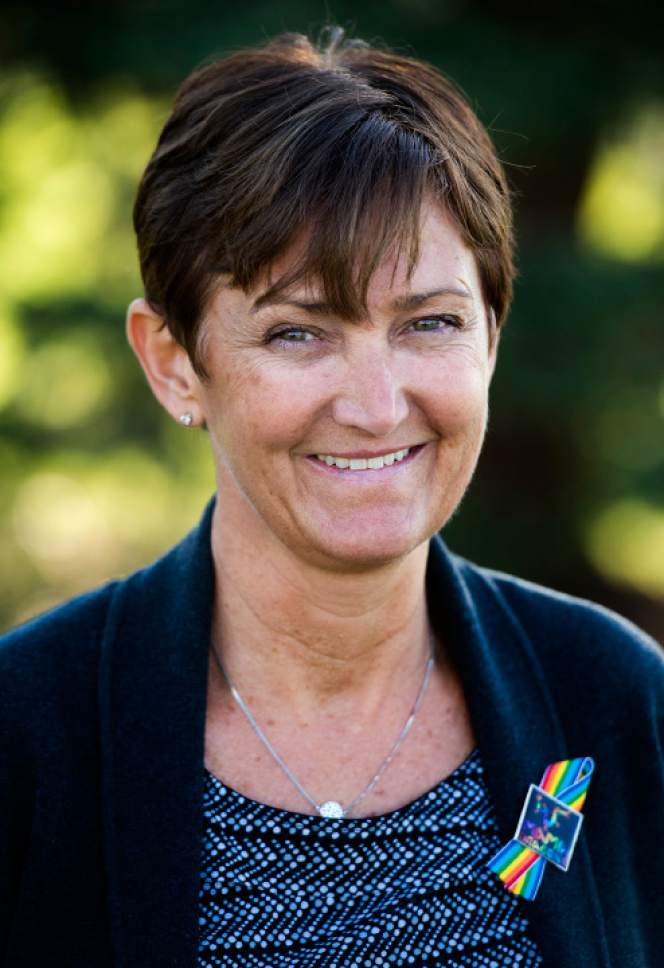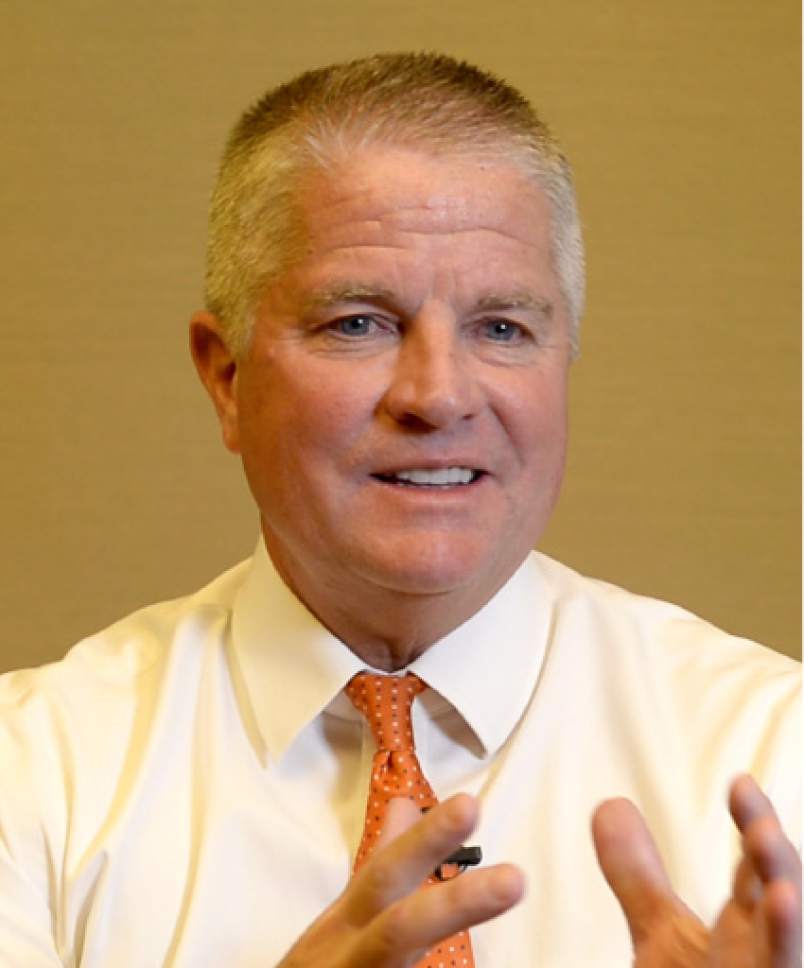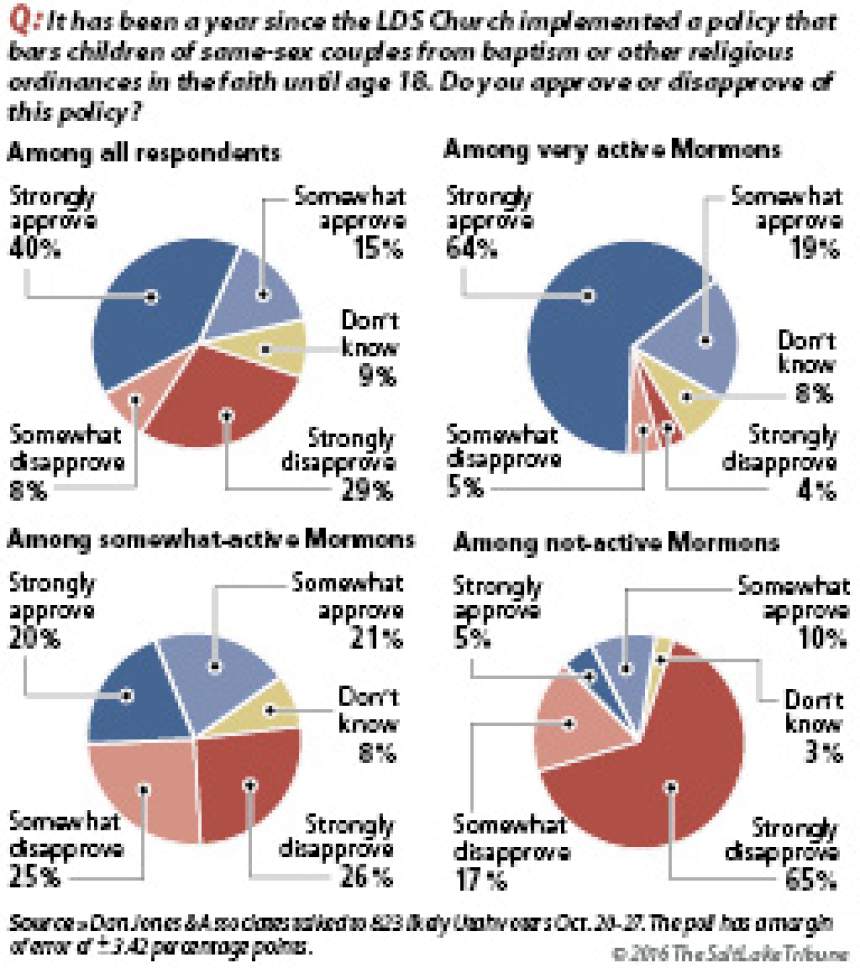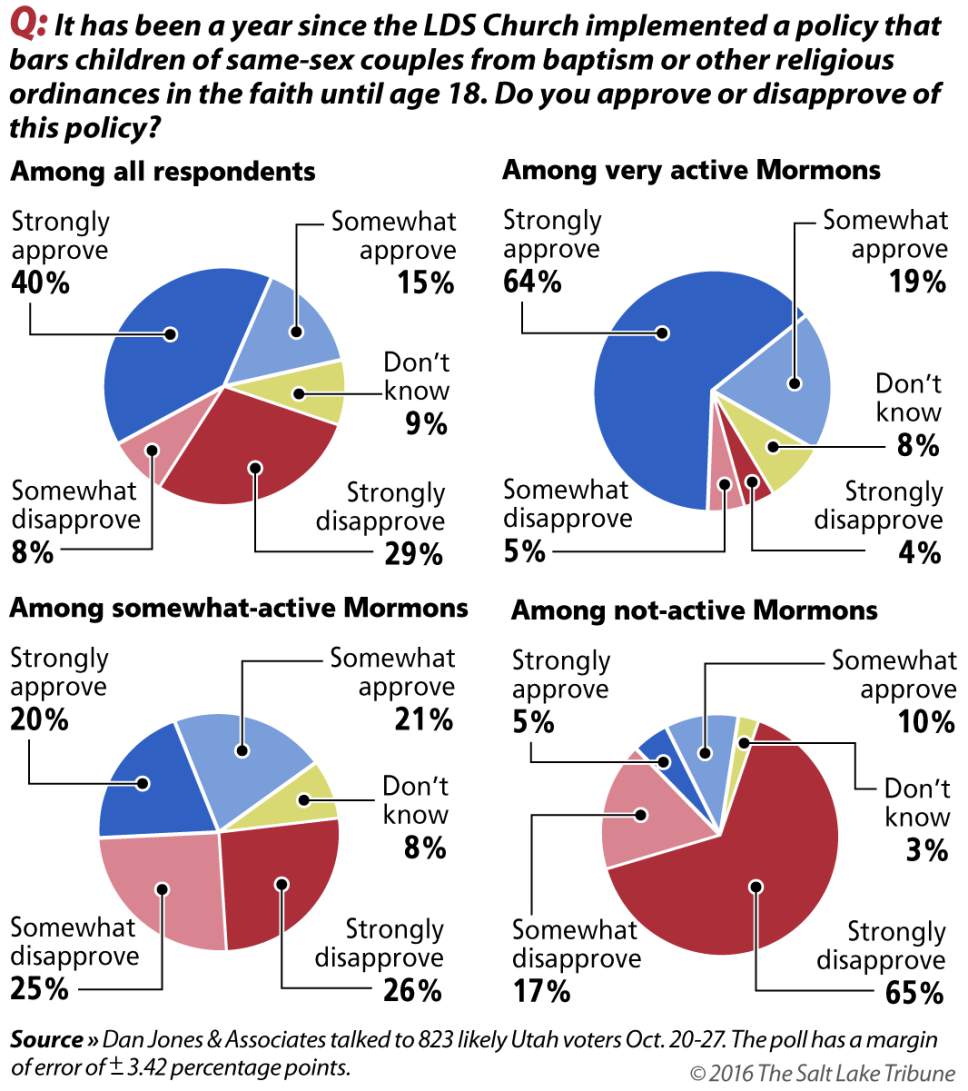This is an archived article that was published on sltrib.com in 2016, and information in the article may be outdated. It is provided only for personal research purposes and may not be reprinted.
Carlin Briggs was driving her car Nov. 5, 2015, when she heard the news: The LDS Church had adopted a policy that deemed gay Mormon couples apostates and barred their children from membership until age 18.
"Hearing it, I stopped the car and said, 'This can't be true,' " recalled Briggs, an LDS convert and three-time president of her Mormon congregation's female Relief Society.
It was true — and a year later, a new poll shows, Utah's LDS faithful support the two-pronged policy, while less-active Mormons and those outside the religion largely — and, in some cases, loudly — oppose it.
Count Briggs among the ranks of disheartened Mormons. The Salt Lake City mother of an adult gay son, who came out five years ago, was stunned and wounded by the directive. After some prayer, she gave up her LDS temple recommend and stopped paying tithing.
"My feelings have become stronger against the policy as I have seen it affect real people," Briggs said, "as I have seen friends' children die by suicide, having children forced to choose between their parents and the church, and parents confused about how they can love their own children and support the brethren."
She is hardly alone in her disaffection, but fresh polling results show that Mormons who back their church's position far outnumber the detractors.
A survey conducted Oct. 20-27 for The Salt Lake Tribune and the Hinckley Institute of Politics found that 79 percent of "very active" Utah Latter-day Saints either "strongly" or "somewhat" approve of the policy on adults, while 83 percent back the stance on children of gay LDS couples.
That backing slips to 46 percent and 41 percent, respectively, among "somewhat active" Utah Mormons, compared with 38 percent and 51 percent who disapprove of the policy.
Opposition swells among "inactive" Utah Latter-day Saints to 58 percent who are against the policy on gay couples and 82 percent who don't like the guidelines about the children.
Among all likely Utah voters, the poll, done by Dan Jones & Associates, found 54 percent either "strongly" or "somewhat" favor the LDS policy on gay couples, with 33 percent against it.
The survey found 55 percent of Utah voters back the ban on LDS religious rites for the kids of gay couples and 37 percent oppose it.
Men generally are more supportive of the policy than women and, somewhat surprisingly, Utah voters between ages 18 and 24 back the church's position by slightly greater margins than many of their older peers.
The overall poll has a margin of error of plus or minus 3.4 percentage points.
When compared to a similar survey conducted for The Tribune in January, the new figures reveal support for the policy has grown.
The earlier poll showed 50 percent of Utah voters favoring the policy on gay couples with 39 percent against it, while 49 percent backed the stance on children and 43 percent opposed it. Nearly three-quarters of the state's Mormons supported both parts of the policy.
The Utah results are similar to a preliminary national "Next Mormons" survey, which shows 72 percent of Latter-day Saints in the U.S. either "strongly" or '"somewhat" agree with the policy on gay couples.
That devotion drops significantly among U.S. Mormons for the position on children. For instance, among active members, those who "strongly" agree with that part of the policy falls to 38 percent, down from 50 percent for the adult portion.
The overall takeaway, however, is that faithful Latter-day Saints heed their church leaders, no matter where they live.
That may be tough to hear for progressive Mormons who have lamented the policy, said Jana Riess, a senior columnist for Religion News Service, who plans to use the data for a coming book.
It also undercuts the notion that Mormons outside of Utah are less strident in their beliefs.
"[That] feels true, having only lived other places," said Riess, a Mormon writer who resides in Cincinnati. "It is not being borne out by the data."
Leaders of The Church of Jesus Christ of Latter-day Saints have said the policy — which leaked out a year ago Saturday and has since been touted a revelation from God — was adopted largely as a response to the Supreme Court decision that legalized same-sex marriage. The policy also was pitched as a way to shield kids from conflicts that could arise from having gay parents whose sentiments clash with expectations of the church.
But conflicts have emerged, often from straight Mormon parents disappointed with their faith's views toward their loved ones.
As the mother of two gay children — a lesbian daughter, who is married, and a son, who ran away from home after coming out — Tammy Hinckley was locked in a philosophical battle with her church's positions on lesbian, gay, bisexual and transgender issues well before the policy.
Still, the new rules have challenged the Salt Lake City mother's belief in the "sense and good judgment" of senior LDS leaders and pushed her closer to giving up the church that has sustained her ancestors for generations.
"The God I know is a lot more loving and a lot less concerned with politics," Hinckley said in response to questions posed by The Tribune through its partnership in the Utah Public Insight Network. "My two gay children know I really would choose family first if forced to choose. And I have been made to feel that it will ultimately be the church that forces that choice upon me. Ironic, no?"
Despite the tug she feels to walk away, Hinckley remains active and teaches Relief Society in her Liberty Park-area congregation.
"My ward members won't let me [quit]," she said. "They've reached out and enveloped me in their love."
Peter Moosman, a 29-year-old gay Mormon, came out just weeks before the policy surfaced. It left him in tears. Still, the returned missionary hasn't lost his love for his faith and has chosen to stay, even though at times he feels unwelcome. He also sees hope within the hurt from the edict.
"It's really helped people to talk about LGBT inclusivity and what that actually looks like in the church," said Moosman, who was pushed out of his Bountiful singles ward after coming out. "The opportunity is creating that conversation and helping members see that gay members of the church are a real thing, and we are not to be feared. We are human and we want to worship alongside them."
Richard Ostler is a testament to Moosman's confidence in the power of such conversation.
A former bishop of a ward for single Mormons in Magna, Ostler began meeting with members of the LGBT community. What grew from that, he said, was love.
"I became an ally," he explained. "I have no LGBT kids. I have no natural skin in the game, so to speak, but I just felt that it's something that Heavenly Father wanted me to do."
Ostler's support for LDS leaders remains unwavering — "They are the best men and women I know," he said — but he also believes the church's relationship with the LGBT community is a work in progress, like a book that keeps adding new chapters.
"We can write new chapters in our book of relationship with the LGBT community, without changing doctrine," he said. "We are not opening a Pandora's box if we open more chapters to find a way to effectively minister. I think there are so many of our LGBT sons and daughters who want to feel comfortable at church."
This story was informed by sources in the Utah Public Insight Network. To become a news source for The Salt Lake Tribune, go to www.sltrib.com/upin.




